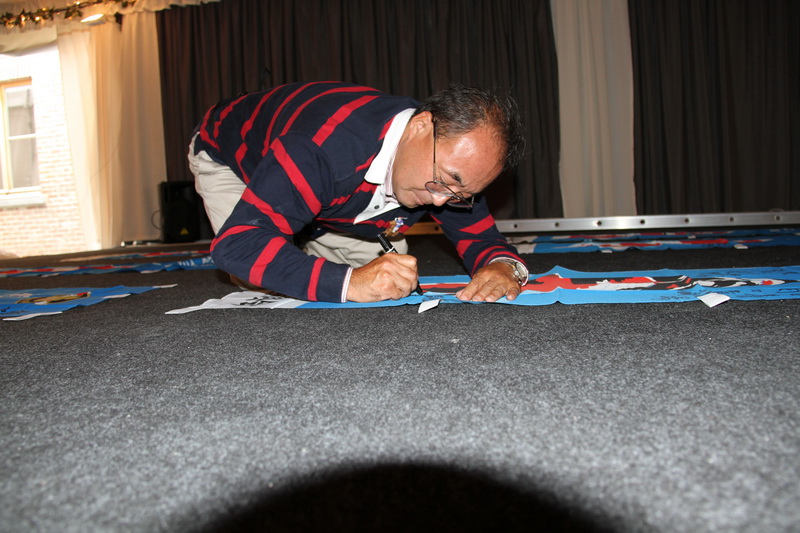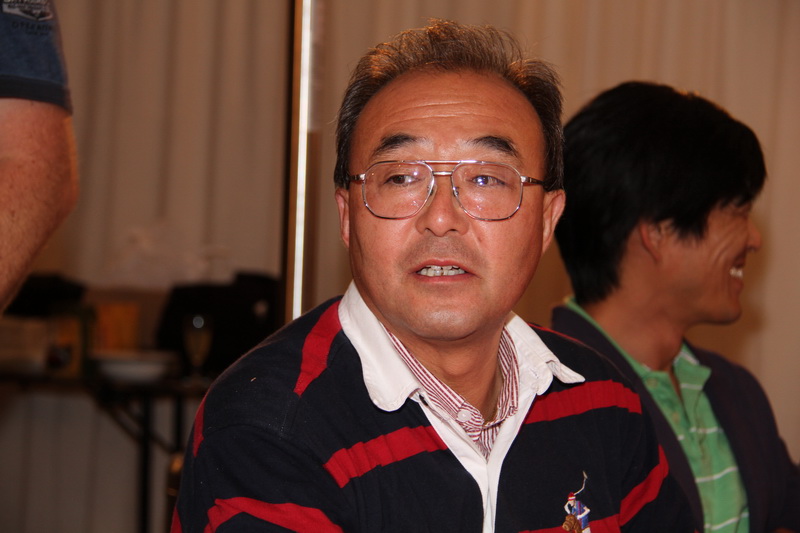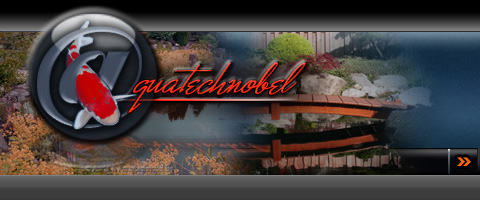|
Special article celebrating the grand opening of Koi Farm ND
< "Importance of “osmo-regulation” >
( Knowing about “osmo-regulation” can help a great deal in helping koi's health )
Nishikigoi Niigata Direct Ltd.
Niigata, JAPAN
Executive Director: Fujio Oomo
Director: Tamikazu Kobayashi
< Basic knowledge in koi keeping >
There
is a Japanese saying, “koi swim up a water fall”, it describes well
that koi have very good physical strength. They can live in wide range
of environments - rivers, swamps, ponds – they can adopt to water
temperature from as low as 3-4 degrees Celsius to 33 degrees Celsius.
It is generally said that the water temperature range that Nishikigoi
like is between 24-26 degrees Celsius, but the range slightly differ
according to their sizes.
From my experience, I'd say, for fry (
from 1cm – 10cm ), 27 – 30 degrees Celsius is the best for them to grow
rapidly with best metabolism, this is also the best

omo koifarmND
temperature
fro them to keep away from most diseases. And for koi over 10 – 20 cm,
the best temperature range is between 25 – 27 degrees Celsius. For koi
bigger than 20cm, the best temperature range is 24 -25 degrees Celsius.
This is my personal opinion based on my experience of koi keeping over 30 years.
<
Please watch for stress koi get from a drastic changes in water
condition and environment, sudden change in water temperature, or from
getting moved from one pond to another. >
Nishikigoi can
adopt to a wide range of water temperature and water condition if it
doesn't happen too suddenly, but we need to take a great attention for
stress from getting moved to one pond to another, or from the stress
from transportation, or from sudden changes in environment, such as
changes in water condition ( ph / Kh ).
<Mainly, there are two factors that cause Nishikigoi to lose their condition >
A
symptom that is caused by sudden changes of environment as I described
before, koi lose condition from a drop down in ability to regulate
Osmotic pressure in their system – not able to keep water out of their
system efficiently. Let me explain, flesh water fish have organs that
work to pump out water out of their body fluid. Normally, the pump
works efficiently to let out water flowing into body. But when koi are
exposed to a stress from sudden changes of environment ( water
condition, getting tired from transportation , etc... ), the function
slows down, then symptom like “dehydration” in humans happen, and koi
shows symptoms such as “sunken eyes”, “reddish body”, with blood vessels
showing on the skin, or “swollen body”.
This symptom is different
from diseases caused by virus or bacteria. This simply happens when
koi's physiological function is not able to keep up with the sudden
changes. Although this is not caused by diseases, it can lead koi to
death.
We need to use “salt” to help koi recover from this symptom
back to normal health condition. Koi are freshwater fish, their
body fluid salinity is 0.7%. So we need to raise the salinity level up
to their body fluid salinity. In this way, it keeps water away from
coming into their body. This is caused by “Osmotic pressure” ( water
moves from low salinity level solution to higher salinity level
solution when two different solution are put together. )
In
this way, we can help koi to rest their body pump, and help them recover
their body organ functions. It is said that fish uses 30% of their
base metabolic energy in “osmo- regulation”, so we can help them save
energy by keeping water salinity close to the salinity level of their
body fluid.
In flesh water fish, the organs that have important roles in
- “Osomo-regulation” ( osmotic pressure control ) are gills and kidnies. At the same time, gills play very important functions of
- gill
respiration ( taking in Oxygen and letting out Carbon dioxide ), and
discharging body waste directly from gill in a form of Ammonia.
So,
when gill functions are slowed down, fish loses the functions of their
main organ in sustaining life. In this very way, keeping salinity level
of the water that fish swim in close to the salinity level of the body
fluid of fish helps fish to better function in osmo-regulation, and this
is an essential requirement for fish to recover their condition. ( It
is the same in human – when we suffer from heat stroke, or dehydration,
we need to take salt and minerals as well as we need to take water.)
Let
me explain more specifically, please prepare 5-6 kg of salt per ton of
water. A lot of times I talk with people having difficulty with their
koi losing condition, I hear them say that they put salt in their pond,
but when I ask in details just how many Kg per ton of water they put
salt, they usually have 2-3 Kg per ton of water. It doesn't work at all
with only 2 or 3 Kgs of salt per ton of water.
By all means, we need to use at least 5 kgs. of salt per ton of water – 0.5 % salinity.
By
now, you understand that “Salt” helps a lot for fish to recover their
condition, but it does not mean that 0.5% salinity kills parasites or
bacteria as I am going to explain later. So we need to be careful to
note this point. The point I'm explaining now about the effectiveness of
salt is only to help fish recover their organ functions in time they
lose condition.
( The use of salt as disinfectant is described in a
book “Manual to Nishikigoi” published by All-Japan Nishikigoi Promotion
Association. )
* Using 0.7% salt over a long period of time can be
harmful to koi's health – it can cause serious damage in koi condition
and may cause koi to die. Salt can be very helpful and brings great
result when used in proper range of salinity level, but it also can be a
“poison” when used beyond the proper range – as we humans, cannot exist
without salt in our body system, but too much intake of salt can be
very harmful to our health, also. So if we consider this complicated
matter in human terms, it looks more simple.
< It takes 5 -8 days for koi to recover conditions with salt in water treatment >
The
days that takes for fish to recover depends on the stages of symptom (
whether the treatment was done at the early stage, or it wasn't
discovered and the treatment was done at the middle stage, or at the
very later stage and the koi were suffering much.)
It takes at
least 6 - 7 days, provided that the water temperature is 24degrees
Celsius and the treatment was taken at the very early stage of
“dehydration”. If the symptom was not discovered early and treatment was
done very late,the rate of deaths raises much higher, and salt
treatment cannot be much effective. We need to be careful that there
often are cases of losing koi in this condition. We need to stop
feeding for 5 to 8 days and wait patiently until koi recover fully.
< It is most important that we spot the changes in condition at the
early stage, and give a treatment at the very early stage. >
In
either cases ( entry 1. or entry 2, which I'm going to explain later )
, it is most important that we discover the changes of koi condition at
the early stage and give a treatment at the very early stage. Koi are
worn out and there will not be enough energy left for fish to recover,
if the treatment was not given at the right time when the change was
not discovered at early stage, or the first aid was not done properly.
In this case, koi may die from multiple organ failure.
Therefore,
it is most important to consider whether the cause of the condition is
from a failure of the Osmo-regulation function, or from some diseases,
or either a mix of some of the causes ( Osmo-regulation function
failure, parasites, bacterial infections, virus infections... ) and
quickly determine how to give treatments.
2. Condition changes ( sickness ) caused by parasites or pathogens ( bacteria, virus)
Fish diseases can be put into three categories;
A) Parasitic diseases
These
are caused by parasites – some of them can be identified by naked eye,
some of them can only be identified by microscopic probe ( 200 x
magnification )
- Anchor worms; most common parasitic
infection. Anchor worms can be seen with naked eye when they are at an
adult stage , but cannot be seen with naked eye at younger stages.
?Treatments;
remove the adult anchor worms on the body surface of the fish. Then
give a treatment with “Dimilin”(R) or “Masoten” ® into the pond water.
*Masoten
is not affective with adult anchor worms, so you need ti give another
treatment with Masoten 14 days after the first one. Dimilin ( powder );
apply 1g per ton of water – Dimilin kills adult anchor worms
2).
Fish lice (Argulus ); also most common parasite. Adult fish lice can be
seen with naked eye. They are shellfish (crustacean) which stick onto
the surface, fins and gills of koi.
?Treatments; These are easily killed with Mazoten ®.
3).
White spot, Trichodina, Costia, Dutilogirus , and others. These cannot
be seen with naked eye, need to be identified with Microscopic probe
(200 x magnification).
?Treatments; Treatment with a mix of three
component of disinfectants ( Formalin, Malachite green and Masoten is
most efficient.
< please do not mix up Formalin with Formaldehyde – I'm referring to Formalin as 40% Formalin. >
*When you use Formalin, please note that you need to check and make sure there is no salt in the water. If Formalin is used with salt in the water, it is very harmful – you can kill koi with this.
?Formula
of this treatment is; take 20-25cc of Formalin, 0.2g of Malachite green
and 0.5g of Masoten ( powder ) and dissolve into plenty of water and
apply evenly to the pond water.
*<CAUTION> When giving
treatments with Masoten, Dimilin and other disinfectants, cut feeding
for three days - the day before, and the day of treatment and the day
after. Also do not use Formalin in a pond with salt in the water.
B) Bacterial infections, fungus and others;
You need to do microscopic probe ( 200 – 400 x magnification ) to identify the cause.
1) Flavobacterium Columnaris, Aeromonas Hydrophyla, new hole disease, water fungus, carp pox, sleeping disease, etc...
?Treatments; for columnaris and Aeromonas, can be treated orally with Oxytetracycline ( Terramycin ® )
Water fungus can be treated with Methylene Blue or Malachite Green
Carp pox can be treated with Potassium permanganate (KMnO4) – apply Potassium permanganate solution to affected area.
Sleeping disease can be treated with raised water temperature (24 degrees Celsius) with salinity level of 0.5 % .
It seems there is no effective medicine for new hole disease at the moment.
C) Koi Herpes Virus disease (KHV)
There
is no effective cure for this disease. Therefore, precaution is the
most effective way to prevent this disease. Do not introduce koi from
natural river or pond, when you buy Nishikigoi, it is strongly
recommended that you buy from breeders, shops, or dealers that takes
KHV tests periodically
(Nishikigoi Niigata Direct Ltd.,
takes KHV tests every 6 months at a specialized institution.We have
taken tests for over 10 years - there have been no test results that
came out positive .)
< There are cases which koi lose condition by eating too much >
In
this case, stop feeding immediately and add salt to the pond water –
5kg of salt per ton of water. It usually takes about a week for koi to
recover a healthy condition. Please keep cutting the feeding until koi
fully recovers the condition.
Nishikigoi are heterothermic animal (
animals that adopt to the temperatures of its environment and changes
body temperature) and their metabolism can go active or less active
according to the water temperature they live in. Their metabolism go
active in warmer temperature – about 24-28 degrees Celsius the
metabolism stay at the top, and below 24 degrees, the metabolism
gradually go down. So, it is better for koi's digestion to give less and
less food as water temperature goes down below 24 degrees Celsius.
(Koi have no stomach – they digest food and absorb the nutrients in their intestine. )
At
water temperature 24 degrees Celsius, food they ate would be completely
digested in about 5-6 hours (duration differ according to food to
food). When water temperature goes down, as koi are heterothermic
animals, metabolism goes down and digestive function also goes down,
digestive enzyme also go down, and it takes longer for koi to digest
food. So at 20 degrees Celsius, you'd want to give 20% less food than at
24 degrees. And at the water temperature of 18 degrees Celsius, better
with a bit less food, then at 15 degrees, it is better to stop feeding
completely – or give little food that is more digestive ( pellets with wheat germ, etc... ),
for instance, once in every two days, give as much food as not to let
them go skinny... when you try and find better ways, it makes koi
keeping much more enjoyable.
Now that greenhouse pond facilities
where you can control water temperature during winter are available, but
for those who keep koi in outside ponds, during fall, when water
temperature goes below 15 degrees Celsius, you'd want to cut feeding
completely and wait until spring when water temperature goes up over 15
degrees and become stable, to start feeding again, slowly and
gradually. It is most adequate way for koi's health. Nishikigoi eat most
amount of food in summer time when water temperature is high, and then
September comes, and as water temperature goes gradually down, they
store in fat in their body to prepare for winter hibernation. So after
they come back from hibernation of the previous year, they eat a lot and
store in fat in July, August and September to prepare for hibernation
in the next winter.
- This is an example for your reference -
water temperature and time of the year would somewhat be different from
place to place, between climate zone you are in. But I would be most
happy to give you some idea for your reference with these.
So
these are a brief explanation about physiological functions,
“Osmo-regulation” (control of osmotic pressure ) function, and
treatments of fish diseases. In most cases, koi are easily affected by
the stress from transportation, adopting to a new environment and lose
condition after they get moved from place to place, in this case, please
observe carefully and find the condition change as soon as possible and
give adequate treatments quickly. In most cases, when koi lose
condition, it helps koi to recover condition greatly to use salt in
water as first aid – 5kg per ton of water.
 - Oomo in koifarmND
|



















